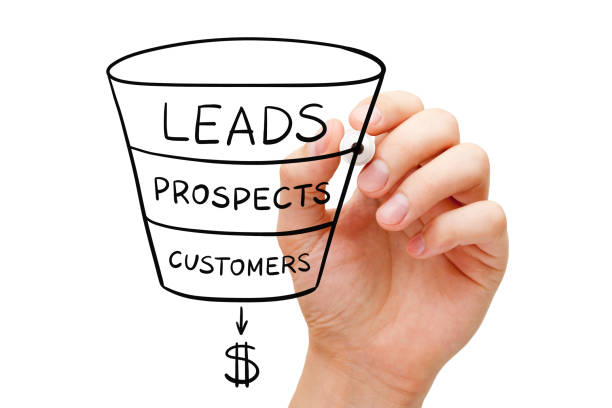Lead generation and search engine optimisation (SEO) are marketing ideas that appear to be similar but are fact entirely distinct from one another. This can make it challenging for business owners to decide where to focus. Both are critical in our opinion. However, the relationship between the two and how they affect your company is linked. So how precisely does SEO impact lead generation and how can they be used together? What are some strategies for making SEO work for lead generation? In this guide, we’ll explore the importance of SEO in the context of lead generation, as well as discuss some SEO lead generation best practices for your benefit.
What is SEO and how is it linked to lead generation?

SEO is the practice of enhancing your website’s exposure and traffic through natural or unpaid traffic on search engine results pages (SERPs). SEO is the technique of refining web pages and content to boost the domain authority of your website and raise your position in the SERPs. The main objective of SEO is to improve website exposure so that you can attract your ideal target audience.
Simply having a beautiful website, while aesthetically attractive, won’t cut it; you need to use SEO tactics in order to procure leads. For example, by employing target keywords in your material, establishing your authority online, and other strategies, you’ll be able to better target your most qualified audience. In order to generate revenue, lead generation relies on increasing customer interest in your goods or services. SEO is therefore a key tool in lead generation for both business-to-business (B2B) and business-to-consumer (B2C) success.
The Role of SEO
SEO aids in your ability to rank for specific business-related keywords. If your content satisfies the demands of your target audience, potential consumers will be more likely to find it through organic search results. These visitors have more potential to become leads.
SEO is an underused tool that can be the key to creating an excellent lead generation strategy that will boost your website to the top. SEO is an inbound marketing strategy, meaning that it aids in attracting leads to your business. And compared to those you approach randomly, SEO leads have a greater chance of becoming customers or service users and they have a pre-existing interest in what you have to offer.
In addition, by making yourself more visible to a larger pool of relevant prospects, SEO may dramatically increase your lead generation efforts. Since your website is constantly updated with new, original SEO rich material that would appeal to the tastes of your audience, using best practices for SEO will make it easier for search engines to find you online.
While this all sounds amazing (and it is!), It’s important to note that SEO is a long-term lead creation approach. You must maintain consistency in your SEO activities to get tangible, dependable results. Compared to other types of internet marketing, this kind of digital marketing operates differently and you cannot always expect to achieve results instantly.
Why SEO and Lead Generation Go Hand-in-Hand

Performing SEO without taking lead generation into account is equivalent to ignoring clients that arrive at your door. Consider putting time, money, and effort into SEO to improve your website. When you begin to rank for business-related keywords, traffic begins to pour in. You suddenly go from having 100 to 1000 visits each month. Are you simply going to ignore the 900 new people that visit your website each month? Obviously not!
The more times your website shows up at the top of the search engine results pages, the more interactions you may have with potential clients. And given that the majority of online interactions start with a search engine, it’s easy to understand why SEO has quickly emerged as one of the most effective strategies for attracting new customers, boosting earnings, and fostering business growth.
In fact, compared to more traditional marketing endeavours, SEO produces more leads. Your website may become one of the most powerful lead-generating tools that generate leads continuously with the help of an excellent SEO strategy.
SEO Lead Generation Best Practices

As previously mentioned, enhancing your website following SEO best practices will be sure to improve your lead generation capabilities. The following best practices and SEO lead generation techniques can be quite useful when using SEO for lead generation.
Defining The Ideal Lead
To begin, you’ll need to pinpoint your target market. You must constantly be aware of who your target market is as this is what will determine the keywords you will focus your SEO strategy on. By defining and developing a client persona, you can provide content that is more focused on their specific issues, challenges, desires, frustrations, motivations, and even purchasing behaviours.
Choosing The Right Intent Keywords
There are fundamentally three steps in a sales funnel to consider: recognition, deliberation, and decision-making. You must plan content that meets a visitor’s needs at each point of their journey and encourages through the funnel if you want to convert them into a lead. You may improve your chances of converting a visitor into a lead, and ultimately a sale, by writing content that contains the appropriate keywords that are relevant to each step of the customer’s journey.
Exploring Different Types of Content
Sometimes writing a blog is insufficient. At each point of the user’s journey, using various content formats might be more useful in meeting user search intent. For instance, you could make an infographic or video that summarises a blog post topic and put it at the top of the page rather than just writing a blog that is a listicle of a topic related to your niche.
A lead magnet, checklist or FAQs that aids the visitor in selecting the finest product in your niche may also be included on this page. By providing interesting and pertinent information, you not only lengthen the time visitors spend on the website but also enhance your chances of converting them into leads.
Optimising SEO Conversion Channels
If you have followed all of the aforementioned advice, your website should attract more targeted visitors. But it doesn’t end there! It’s time to step up lead-generating strategies so that all of those new site visitors become leads. These strategies can include things like providing downloadable information that satisfies search intent to top-performing blogs, placing appealing calls to action on service pages, and generating internal links to other pertinent content.
Competitor Analysis
Why reinvent the wheel if it has already been made? More often than not you can pick up a lot from your rivals. You can learn what’s working, what’s ranking, and what you need to get above them in search results through a solid SEO competitor analysis. You may simply discover what exactly you don’t want to do and that’s still enough! Using a number of free tools available online, you can compare traffic statistics from other rivals, including how many unique visitors they receive each month and get a better understanding of what successful competitors are doing that you may not be.
Get Started Now!
SEO and lead generation are two important aspects of online marketing. By understanding the role of SEO and how it can help you generate leads, you can better focus your efforts on creating a successful strategy. The best practices we’ve outlined will give you a strong foundation to start from, but keep in mind that each business is different and what works for one may not work for another. Experiment with different techniques and find what works best for you.
If you’re interested in kicking your SEO and lead generation strategy up a notch, get in touch with Straight Up Search to learn more about our services and to receive your free consultation.